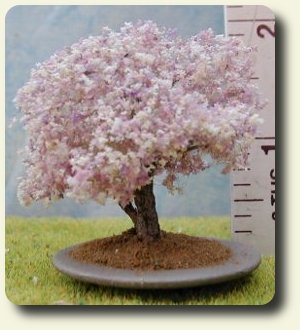
Featured Gallery
Page 4
August 2010, Issue 7


 "Often I am asked 'can you do such and such a tree?' Thus I add new species to my repertoire. When I freelance trees for a show some species always sell better than others so I make these in several scales for shows.
"Often I am asked 'can you do such and such a tree?' Thus I add new species to my repertoire. When I freelance trees for a show some species always sell better than others so I make these in several scales for shows.
"Last April I also purchased the Tiny Trains part of my business from Tanis of Tadpoles Miniatures. This is great fun working in 1/900 scale and I have just purchased a small industrial laser cutter to enable a greater range of buildings to be produced to go with these. My husband also has designs upon it for railway kits," she said.
State of the art tools, the latest mediums, or even the best reference materials will never take the place of an artist's most valuable tools and Jax readily agrees.
"My main tools are my hands - and since I lost 80% of the use of my right arm a couple of years back culminating in an operation on the nerves around the
 elbow - the result of which will still be unknown for some years - I now sculpt left-handed, but have yet to master painting that way and can, therefore, only paint when the arm is willing."
elbow - the result of which will still be unknown for some years - I now sculpt left-handed, but have yet to master painting that way and can, therefore, only paint when the arm is willing."
This may slow her down a bit, but there is no stopping her when it comes to her craft.
"The quickest part of making a tree is the skeleton. It can take as long to paint a tree as make the wire framework, and sometimes it can take a whole day to put the foliage on to form the correct shape."
And the research that goes into her work can be more extensive than the casual observer might expect.
"Especially from the railway perspective it is very important to be aware of the social history of trees, such as Dutch elm disease dates; the current problem with horse chestnuts; when certain species were introduced to areas, etc."
Having the support of her husband, who not only works in the railroad business but has his own collection of model railways, is one of the things for which Jax is most grateful.
Custom Dolls, Houses & Miniatures / CDHM







